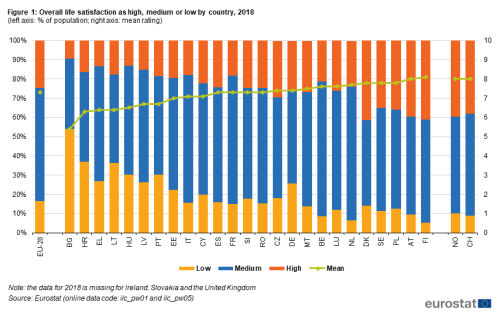Archive:Absences from work - quarterly statistics
Data extracted in Month YYYY
Planned article update: Month YYYY
Highlights
Tweet Text
Tweet Text
<Interactive graph to be set by unit B4:>
or
or
The absences from work can be classified in two groups: at one side, the planned, desired absences (e.g. annual holidays) and at the other side, the unplanned, undesired absences (e.g. illnesses, lay-offs). Whereas the first type of absences could be easily “absorbed” by the companies as their effect could be mitigated by for example rescheduling the work priorities or recruiting temporary staff; the second type could lead to disruption of the production cycles and lead to material losses to both employers and employees.
It is worth noting that sometimes this distinction could be not so easy to make. Usually, annual leaves are guaranteed by the legislation, which may lead some employers to encourage their employees to take holidays when the enterprise is facing economic difficulties. This means that holidays sometimes may mask actual lay-offs.
The beginning of 2020 was marked with an outbreak of worldwide pandemic - COVID-19, which led almost all governments around the globe to take restrictive measures, of which the social distancing had a pivotal role. To prevent the spread of the virus and to ensure distancing of people, many businesses were temporarily shut down and many employees were confined at their homes. Whereas worker protection laws may imply that employment, specifically of employees, will not be affected, at least in the beginning of the pandemic, one may expect over time a sharp rise of absences from work, which fall under the aforementioned second category of undesired, unplanned absences.
This article aims to depict the absences from work in the European Union as a whole and in the different EU Member States. The article is a part of the online publication … alongside with the articles …
Direct access to
Main tables
- Title(s) of second level folder (if any)
- Title(s) of third level folder (if any)
Database
- Title(s) of second level folder (if any)
- Title(s) of third level folder (if any)
Dedicated section
Publications
Publications in Statistics Explained (either online publications or Statistical articles) should be in 'See also' above
Methodology
<link to ESMS file, methodological publications, survey manuals, etc.>
- Crime and criminal justice (ESMS metadata file — crim_esms)
- Title of the publication
Legislation
- Use Eur-Lex icon on the ribbon tool at the top of the statistical article to enter the year and reference of your regulation or directive.
- See example of what should be issued hereafter
- Regulation (EU) No 1013/2016
Visualisations
- Regional Statistics Illustrated - select statistical domain 'xxx' (= Agriculture, Economy, Education, Health, Information society, Labour market, Population, Science and technology, Tourism or Transport) (top right)
External links
Notes
<footnote text will be automatically inserted if reference tags are used in article content text (use reference icon on ribbon)>
[[Category:<Subtheme category name(s)>|Name of the statistical article]] [[Category:<Statistical article>|Name of the statistical article]]
Delete [[Category:Model|]] below (and this line as well) before saving!
